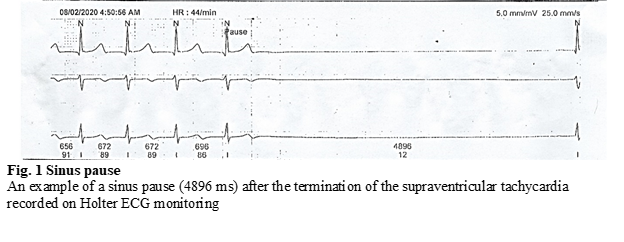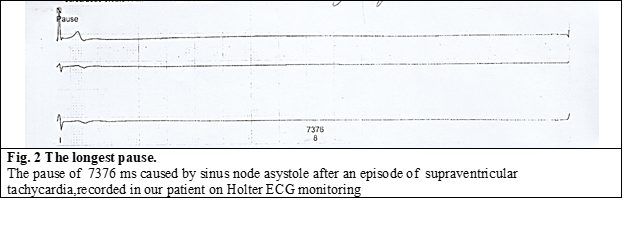Introduction
According to the medical literature, the presence of prolonged sinus pauses is quite rare in children and adolescents with structural normal heart. It has been diagnosed with increasing frequency in children and young adult patients with congenital heart defect, especially in patients who have undergone corrective cardiac surgery related with atrial tissue [1]. In addition, abrupt termination of a supraventricular tachycardia (SVT) can be associated with sinus pauses due to overdrive suppression of the sinus node [2] (Fig. 1). In the described case we faced the choice of implanting a cardiac pacemaker or treating the supraventricular tachycardia by ablation.

Case report
We present a case of 16-years-old girl who had atrioventricular nodal reentrant tachycardia (AVNRT) soon after birth. At 3-years-old, she had an ablation of AVNRT (2008), after which the patient remained asymptomatic for a long time. After 12 years the patient addressed with complaints to frequent episodes of rapid heartbeats followed by dizziness. We performed Holter ECG monitoring and found paroxysms of atrial tachycardia that ended with 970 sinus pauses > 2500 ms, the longest pause was 7376 ms (Fig. 2).

We decided to avoid pacemaker implantation taking in consideration the young age and clear relationship between atrial tachycardia and sinus pauses. Our strategy was first to perform an electrophysiological study to diagnose the tachycardia type. Two diagnostic quadripolar catheters were placed into the high right atrium and the coronary sinus. A deflectable ablation catheter was used for mapping the atrial tachycardia.
The presence of atrial tachycardia originating from the ostium of the coronary sinus was demonstrated, during the application of the radiofrequency currents, the tachycardia stopped, and the sinus rhythm was restored.
The patient was evaluated by the Holter ECG after 1 month and 6 months, and neither atrial tachycardia, nor sinus pauses were found. She is remaining asymptomatic.
Discussion
Sinus node dysfunction with long sinus pauses is rare in children with structurally normal heart [1, 2]. There are a lot of data demonstrating that overdrive suppression of the sinus node in the context of atrial fibrillation may result in sinus pause. This phenomenon is quite rare in children [3, 4]. Reports about adults have shown that ablation of the atrial fibrillation can lead to resolution of the sinus pauses. Some researchers reported the use of the same strategy in children [4].
After discussing with the parents and the patient all the possible management scenarios, we decided to manage the tachyarrhythmia with catheter ablation. The ablation was preferred over medication because of the potential risk of worsening of the bradycardia due to antiarrhythmic therapy. The decision was influenced by the fact that our patient supported ablation of AVNRT in the past, has a normal cardiac structure and function on echocardiography.
Pacemaker placement would have been a permanent intervention with possible future side effects such as infection, lead dislodgement, and cosmetic defect. Ablation was preferred as a definite procedure.
Conclusions
Even in some young patients, paroxysmal SVT could be complicated with long sinus pauses. The optimal therapeutic solution should be directed towards the SVT treatment and not to the bradyarrhythmia. The majority of SVT could be cured by catheter ablation.
Competing interests
None declared.
Consent for publication
Written informed consent was obtained from the patient for publication of this case report and any accompanying images.
Authors' contributions
All the authors have contributed equally at the results presentation in the paper.
Authors’ ORCID IDs
Irina Boiciuc – https://orcid.org/0009-0007-5891-0030
Radu Darciuc – https://orcid.org/0000-0003-2088-9129
Basri Amasyalı – https://orcid.org/0000-0002-0009-7135
Erdem Diker – https://orcid.org/0000-0003-4249-948X
References
Yabek SM, Dillon T, Berman W Jr, Niland CJ. Symptomatic sinus node dysfunction in children without structural heart disease. Pediatrics. 1982 May;69(5):590-3.
Balaji S. Management of paroxysmal ectopic atrial tachycardia with long sinus pauses in a teenager. Indian Pacing Electrophysiol J. 2016 Feb 12;15(5):249-50. doi: 10.1016/j.ipej.2016.02.003.
Kardelen F, Celiker A, Ozer S, Ozme S, Oto A. Sinus node dysfunction in children and adolescents: treatment by implantation of a permanent pacemaker in 26 patients. Turk J Pediatr. 2002 Oct-Dec;44(4):312-6.
Mandel WJ, Hayakawa H, Allen HN, Danzig R, Kermaier AI. Assessment of sinus node function in patients with the sick sinus syndrome. Circulation. 1972 Oct;46(4):761-9. doi: 10.1161/01.cir.46.4.761.

